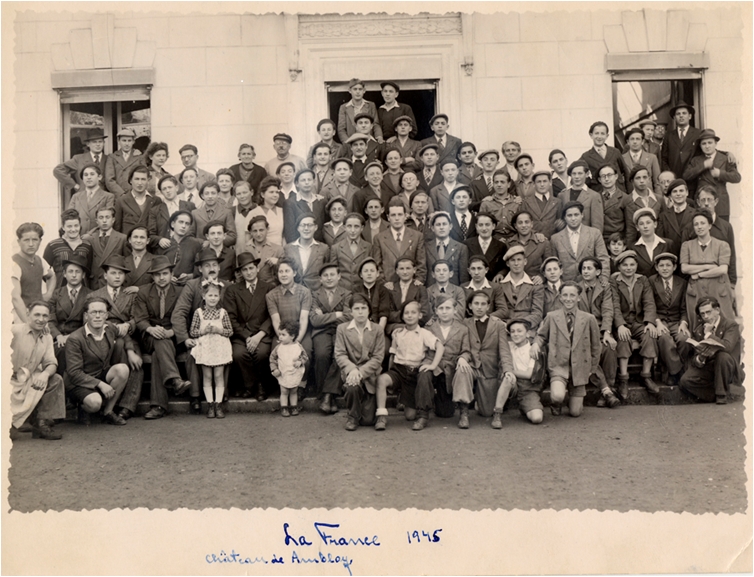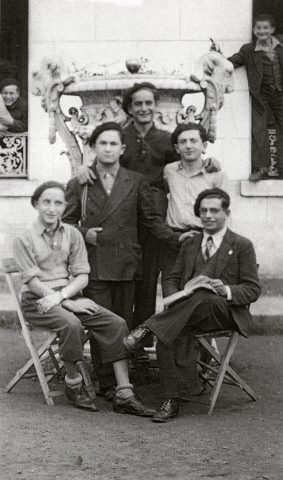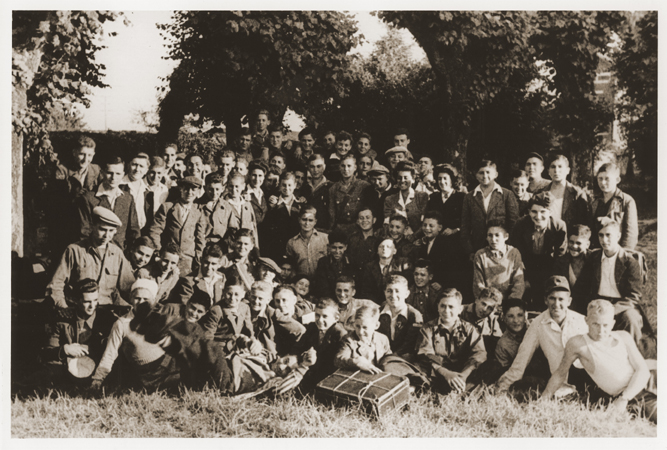New Photos of Elie Wiesel in France
By Carolyn Yeager
Pictured: front left, Kalman Kalikstein; Binem Wrzonski (middle right), and Elie Wiesel (back center).
This picture is now available for purchase at the USHMM website. The information about it is given as follows:
Date: 1945-1946
Locale: Ambloy (Loir-et-Cher) France
Credit: United States Holocaust Memorial Museum, courtesy of Binem Wrzonski
Copyright: United States Holocaust Memorial Museum
Title: Group portrait of boys in the Ambloy children’s home.
USHMM Commentary: In June 5, 1945, Binem joined a group of boys and young teenagers, known as “The Buchenwald Boys” who were brought to France in a special convey under the sponsorship of the O.S.E. They first were brought to Ecouis in Normandy. An aid worked (sic) helped Binem to make contact with his one surviving sibling, Towa who had spent the war in the Soviet Union. From Ecouis the children were taken to either secular or religious homes. Binem at first wanted to go to a secular home, but Leo Margolis, a German Jew who was in Buchenwald for approximately six years and helped care for the children, persuaded him to go to a religious home. Binem then went to Chateau d’Ambloy. From there he went to Taverny. Then together with two other teenagers, with Elie Wiesel and Kalman Kaliksztajn, he accompanied a group of younger boys to Chez Nous in Versailles where worked as a counselor. From this experience, Binem decided to become a teacher. After training in France, he immigrated to Israel and became the principal of a Youth Aliyah boarding school. In Israel he met and married Rahel Schlezinger and they went on to have five children and many grandchildren and great-grandchildren. In 1983 Binem returned to Lodz and erected a new marker at his father’s graves including the names of all of his family members who died during the Holocaust. [end of USHMM commentary]
* * * *
Binem came from Buchenwald, but not Elie Wiesel and maybe not his good friend Kalman!
What is amazing about this commentary on the picture above is that Elie Wiesel is NOT said to have been at Buchenwald with Binem, but encountered him at Taverny. Elie and Kalman, according to Binem, accompanied a group of younger boys to Chez Nous in Versailles where they worked as counselors. This actually makes a lot more sense. A narrative in which Elie Wiesel is not a withdrawn, scarred youth from the concentration camps, but possibly arrived in France sometime during the war—helped by the Jewish network and placed in the children’s welfare institutions—is quite possible. There, he associated with some of the youths who were sent after the war, and developed his “knowledge” of concentration camp life from them.
Is this why he had no interest in gaining French citizenship—because he was devoted to the Jewish cause of Eretz Israel and always connected to and working with the Jewish Underground? (See Elie Wiesel and the Mossad)
Was Elie Wiesel actually a youth counselor for Buchenwald boys, rather than one of them?
Can this explain why he remained with the welfare agencies for so long and was one of the oldest to leave his last home at Versailles to live on his own? His friend Kalman left for Israel in 1947 before Elie managed to get a room of his own “at the end of summer” at the age of 19. This would have been after his birthday on Sept. 30.
Compare this photograph with the one below, which the USHMM identifies as:
Group portrait of the staff and boys of Ambloy, an OSE home for religious youth.
Among those pictured are (First row, left to right): Natan Szwarc, Izio Rosenman, Deblin, unknown and perhaps Berek Rybsztajn. (Third row): Abraham Tuszynsky (2nd from left, first boy next to woman), Andre Zelig is in the center with a tie and his hands on the boy in front of him and Elie Wiesel (second right of Tuszynsky). Binem Wrzonski is to the right of Elie Wiesel. The donor, Jakob Rybsztajn is in the fourth row, fifth from the left.
This picture is available for purchase from USHMM website. The information given about it is as follows:
Date: 1945
Locale: Ambloy, (Loir-et-Cher) France
Credit: United States Holocaust Memorial Museum, courtesy of Jacques Ribons
Copyright: United States Holocaust Memorial Museum
The inscription on the back reads “Before our departure from Chateau Ambloy for Paris.”
USHMM Commentary: Jakob Rybsztajn (now Jacques Ribons) is the son of Peretz Rybsztajn (b. 1905) and Bella (Bajal, b. 1906) Rybsztajn. He was born on August 15, 1927 in Strzemieszyce Poland where his father was a textile manufacturer. He had two younger siblings: Bernard (Berek) who was born in 1929 and Esther who was born in 1935. In 1933 the family moved to Zelow, Bella’s home town. The family remained there until 1936 when it moved back to Strzemieszyce. In 1939 Germany invaded Poland later the Rybsztajns were forced to move to a ghetto. Jakob attended a ghetto Hebrew school. Peretz Rybsztajn, his father, worked with or was close with the Jewish Council but he soon disappeared. After the ghetto was liquidated, probably in June 1943, Jakob and Berek, who initially had hid, were forced to return and then sent briefly to Bedzin. In September they were deported to the Blechhammer concentration camp where they were forced to work unloading cement from train cars, insulating oil and fuel tanks with asbestos, and cementing steel forms to the tanks. They lived in a barrack with other boys their ages, including Kalman and Heniek Kaliksztajn, two brothers also from Strzemieszyce. In January 1945 the Germans liquidated the camp in advance of the Soviet army, and the brothers were sent on a death march via Gross Rosen and by open train to Buchenwald. They arrived in Buchenwald on February 10, 1945, and were placed in the children’s block, Block 66.
Jakob and Berek remained together in block 66 until they were liberated in Buchenwald by the U.S. Third Army in April. The boys in the barrack, under the supervision of Gustav Schiller, the deputy block elder, did not work and received occasional Red Cross packages distributed from other prisoners in the camp. After liberation, the Rybsztajn brothers joined a children’s transport to Ecouis in France, sponsored by the O.S.E., where they were through the summer. But, as they were religious, they were sent from there with other religious boys, including the Kaliksztajn brothers, also Elie Wiesel, to children’s homes in Ambloy and Taverny. Then Jacques came to Paterson New Jersey and later enlisted in US army during the Korean conflict. He arrived in New York in February 1947 on board the Gripsholn, a Swedish ship. Berek was adopted by the Homberger family in California. Later he was in Israel and served in the Israeli Defense Forces; he returned to California in the late 1950s. Jacques also settled in Los Angeles. The Rybsztajn parents, Perez and Bella Rybsztajn, and their sister younger sister Esther perished in Auschwitz, it is believed, during 1943. [end of USHMM commentary]
* * * *
If it can be proven that this is indeed Elie Wiesel in the two pictures, we still do not know if he arrived in Ambloy from Buchenwald.
We have learned that others were there already and the Buchenwald boys joined them. He may have been one of those who were already there. The commentary states as an afterthought that “also Elie Wiesel” was among those sent to Ambloy and Taverny. Where are the records that must have existed? In what capacity was Elie Wiesel there?
The person identified in each photo above as Elie Wiesel is dressed in the same clothing, so the pictures were most likely taken on the same day. The boy Binem may simply have taken off his jacket in the more casual top picture. But where is Kalman in the large group photo? He is not identified and appears to be missing. Rather than pictures on more than one occasion, we have two different pictures taken at the same time.
The group is dressed for travel to Paris (Versailles). It must have been later than 1945 that they transferred to the home in Versailles, so this picture should probably be dated 1946, as is the top picture. All of these questions I raise show the poor scholarship done by the USHMM and the holocaust historians in general. Slip-shod reporting is picked up from here and there, thrown together, becoming the “story” that fits the bill. Thus we have Elie Wiesel’s name stuck in where they want it to be, to try to show that he was one of the Buchenwald boys, when actual proof doesn’t exist.
These photographs only portray someone who could be Elie Wiesel at a home in Ambloy, France where some of the boys from Buchenwald, and also Jewish boys from elsewhere, lived for a time.
As far as the next picture is concerned, I now cannot be sure that these boys are arriving from Buchenwald. They are only identified as Jewish DP (displaced persons) youth at the USHMM website:
Group portrait of Jewish DP youth at the OSE (Oeuvre de Secours aux Enfants) home for Orthodox Jewish children in Ambloy. Elie Wiesel is among those pictured. [Photograph #28147]
This photo is also available for purchase at USHMM website. The information given about it is as follows:
Date: 1945
Locale: Ambloy, (Loir-et-Cher) France
Credit: United States Holocaust Memorial Museum, courtesy of Robert Waisman. Willy Fogel
Copyright: United States Holocaust Memorial Museum
In this case, none of the boys are identified by name. In the long commentary that accompanies the picture on the page, there is no mention at all of Elie Wiesel. I will say that no one in this picture is wearing a beret! Once again, if the USHMM or Prof. Ken Waltzer claim that Elie Wiesel is in this picture, they must point him out.
It has never been disputed that Elie Wiesel was in France. But just when he arrived and what he was doing there is not documented.
* * * *
The next step for the reader is to compare the face of “Elie Wiesel” in the first two photos above with the faces of “Elie Wiesel” in the famous Buchenwald photo and the boys marching out of the Buchenwald gate, plus his portrait as a 15-year-old, that are found at “The Many Faces of Elie Wiesel.” They can’t all be Elie Wiesel. It’s up to you—and up to USHMM and Ken Waltzer, and how about the old liar Elie Wiesel himself!—to decide and announce which ones are. When that is clear, we can then decide what the pictures are telling us.



